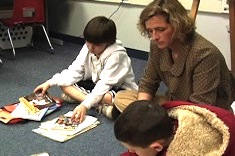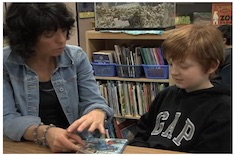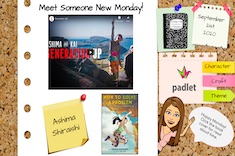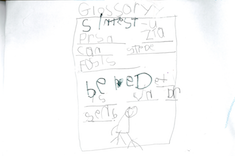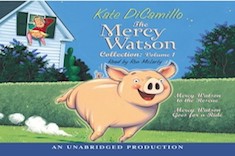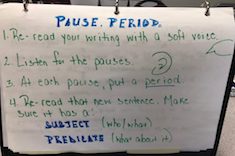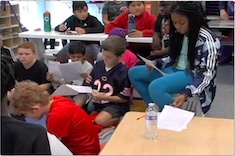4th
Latest Content
One Instructional Strategy Changes a Reading Community: Status of the Class
Mandy Robek reminds us of the power of a status of the class to build a reading community.
A Roving Student Conferrer
Tammy Mulligan encourages students to support their peers as writers by being a “roving student conferrer.” When we enable students to take on the role of the teacher, it helps solidify what they know, as well as take pride in their writing skills.
Words of Wisdom and Passing the Torch
Melanie Quinn shares a fun activity to help current students share advice for next year’s class.
Importance of Talk in Writing Workshop
Julie Johnson reminds us of important mindsets to adopt to allow students the space and permission to talk while composing. When students talk as writers, they have opportunities to create new understandings, build relationships, and validate each other.
Conferring with Reading Partners in Fourth Grade
Andrea Smith talks with two boys about the book they are reading, Island. They discuss the way their partnership is going, even though the partners are reading at different paces.
Online Routines to Create Energetic Reading Communities
Melissa Quimby shares online routines to strengthen the class reading community.
Assessing Students Online: Small and Powerful Moves
Tammy Mulligan shares small and mighty moves when assessing students online.
Building Writer Relationships with Author Studies
Matt Renwick shares creative ways teachers in his school celebrate authors.
Making Something Together: Shared Writing Online
Tammy Mulligan finds shared writing is her go-to strategy for teaching young learners online.
Supporting Students as They Exit Intervention with Series Books
Tara Barnett and Kate Mills write about the power of series books in helping young readers build skills and independence as they exit intervention programs.
Changing How I Teach Small Groups
Tammy Mulligan listens to students and adapts her small-group instruction as they share how they learn.
Fourth-Grade Reading Group: Goals in Fiction
Gigi McAllister leads a group of fourth graders in discussing characters and their quests or goals in the story.
Partner Reading: Quick Share
Gigi McAllister has two reading partners in her fourth-grade classroom do a quick practice of retelling their stories.
Balancing Conferences and Small Groups
Balancing small groups and conferences is essential for transferring learning from lessons and units, and it’s one of the trickiest tasks for teachers. Dana Murphy explains how she works toward balance in her classroom, weighing everything from the timeline of the unit to the intensity of the minilesson.
Navigating the Interpretation Process
Tammy Mulligan shares how she introduces students to the process of interpreting literature at different grade and developmental levels.
Owl Design Strategy Group Meeting
Andrea Smith meets with a group of fourth-grade girls who are completing designs as part of the owl habitat project.
Interpretation and Comprehension
Teaching comprehension skills can be a complex and overwhelming task. Tammy Mulligan shares a process for expanding and deepening student interpretations of text.
Making Learning Stick: Learning Progressions and Student-Created Exemplars
Tammy Mulligan explains the process of having students analyze and create models of good writing and analysis for assessing themselves and peers.
Teaching Constructed Response Before Exams
Teaching the genre of tests can seem far removed from writing workshop. Matt Renwick explores how to teach constructed response in a way that is integrated with the tenets of good workshop instruction.
Writing Partners
Partner work is an essential component of many literacy workshops. Dana Murphy explains how she is intentional in building thoughtful routines and expectations for partner work in her fifth-grade classroom.
When Learning Gets Tricky, Go Back to the Pigs
Whenever a tricky literary concept comes up, Tammy Mulligan finds herself returning to a favorite mentor text to guide students. She explains the value of shared simple stories for understanding complicated literary elements.
Teaching Conventions in Small Groups
Dana Murphy finds it is best to teach conventions in small, targeted groups in her fifth-grade classroom. She explains how she designs and leads these groups.
Building Reading Identities Across the Year
The start of the school year is often all about building reader identities in classrooms. And then October comes, and many of the activities that help students celebrate their reading histories and preferences are forgotten. Tara Barnett and Kate Mills share ways teachers can continue to help students define, refine, and expand their reading identities all year long.
Text Sets: Reading Beyond Just Facts
Franki Sibberson explains how carefully curated text sets can help students move beyond a “just the facts” exploration of nonfiction topics.
Finding Time for Writing Shares
Finding time for writing share sessions may begin with trying out a few different options to see what works in your classroom. Melanie Meehan presents some of her favorites.
Circle Share
Sometimes “winging it” because we don’t have plans can lead to the most profound learning. Dana Murphy dreams up a quick circle share, and what follows is magic.
Owl Research: Getting Organized
Andrea Smith checks in on a group of boys who are doing research into owl habitat, helping them organize their work and plans.
The Power of Video Replay
Heather Fisher explains how viewing excerpts from the same video multiple times can help students in book clubs hone their conversation and reflection skills.
Book Club Tools
Tammy Mulligan shares the importance of giving students choice and agency with book club tools to improve engagement and the quality of the conversations.
Moving from Interactive Read Alouds to Book Clubs
Tammy Mulligan shares how teachers can move seamlessly from thoughtful conversations during whole-class read alouds to lively book clubs.
Browse Content By
Type
Category
- Assessment Tools
- Big Fresh Archives
- Booklists
- Choice Numeracy
- Classroom Design
- Common Core
- Community Building
- Conferring
- Content Literacy
- Digital Literacy
- English Language Learners
- Equity
- Family Relations
- Free Samples
- Guiding Groups
- Leadership
- Literacy Coaches
- Mentor Texts
- Minilessons
- New Teacher Mentors
- Podcasts
- Poetry
- Quote Collections
- Reading Strategies
- Self Care
- Struggling and Striving Learners
- Talking and Listening
- Teacher Study Groups
- Teaching Reading
- Teaching Writing
- Word Study and Vocabulary
Author
- Melissa Quimby
- Nawal Qarooni
- Gwen Blumberg
- Julie Cox
- The Lead Learners
- Hannah Tills
- Josie Stewart
- Ruth Metcalfe
- Mallory Messenger
- Becca Burk
- Jodie Bailey
- Vivian Chen
- Mary Brower
- Tiffany Abbott Fuller
- Stephanie Affinito
- Ruth Ayres
- Leigh Anne Eck
- Heather Fisher
- Shari Frost
- Julie Johnson
- Suzy Kaback
- Gigi McAllister
- Shirl McPhillips
- Melanie Meehan
- Cathy Mere
- Debbie Miller
- Tara Barnett and Kate Mills
- Tammy Mulligan
- Dana Murphy
- Bitsy Parks
- David Pittman
- Brenda Power
- Heather Rader
- Matt Renwick
- Mandy Robek
- Christy Rush-Levine
- Gretchen Schroeder
- Jen Schwanke
- Brian Sepe
- Katherine Sokolowski
- Stella Villalba
- Jennifer Vincent
Grade Level
Choice Literacy Membership
Articles
Get full access to all Choice Literacy article content
Videos
Get full access to all Choice Literacy video content
Courses
Access Choice Literacy course curriculum and training


